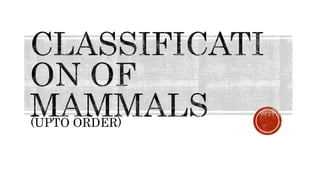
Tracing the Class Mammalia Classification
- 1. (UPTO ORDER)
- 2. “Classification” – arrangement of organisms in taxonomic groups according to their observed similarities. Tracing the class Mammalia “Life” - an organismic state characterized by capacity for metabolism, growth, reaction to stimuli, and reproduction Three domain classification by Carl Woes (1980)
- 4. 1. Hair-clad 2. Terrestrial 3. Air-breathing 4. 2 pairs of limbs 5. Glands: sweat, scent, mammary 6. Diaphragm 7. Heart 4 chambered 8. Parental care well developed 9. Brain well developed 10. Sexes separate, etc.
- 5. By George Gaylord Simpson (1945) Characters taken into consideration: 1. Parental care 2. Dentition 3. Foot posture 4. Nails, Claws, & Hoofs (exoskeleton) 5. Nervous system (Brain) 6. Systematics 18 living orders divided into 2 sub-classes
- 6. General characters: 1. No pinna 2. Cloaca is present 3. Mammary glands lack nipples 4. No corpus callosum 5. Oviparous 6. Testes are abdominal Order: Monotremata Example: Duck-billed Platypus, Echidna.
- 7. General characters: 1. Viviparous 2. Pinna present 3. Nipples/Teats present 4. Teeth present 5. Testes in scrotal sac 6. Oviduct opens into vagina Divided into 2 infra-class: Metatheria & Eutheria
- 8. General characters: 1. Marsupium/brood pouch pr. 2. Vagina & uterus are double 3. Rudimentary yolk-sac placenta Order: Marsupialia Example: Opposum, Kangaroo,etc.
- 9. General characters: 1. Higher viviparous 2. Corpus callosum pr. 3. Testes pr. in scrotal sac 4. Single vagina 5. Embryo nourished by allantoic placenta 6. Young one is born in a relatively advanced state Divided into 16 orders
- 10. General characters: 1. Small animals 2. Feet: 5 toed, plantigrade 3. Nocturnal 4. Placenta discoidal 5. Snout long and tapering 6. Insectivorous 7. Molars pointed and peg like Example: Mole, hedgehogs,etc
- 11. General characters: 1. Gliding mammal 2. Incisor: 2/3 3. Nocturnal 4. Equal sized limbs, and tail included in the patagium Ex: “Flying Lemurs”
- 12. General characters: 1. Forelimbs => wings (patagia) 2. Hindlimbs short included in membrane 3. Ears with large pinnae 4. Nocturnal 5. True flight 6. Teeth small, sharp, peg-like 7. Vision weak 8. Sternum has keel Example: Flying fox, vampire bat, etc.
- 13. General characters: 1. Only molars pr. or teeth abs. 2. Testes are abdominal 3. Toes with large, strong, curved claws Example: Sloth, Anteater, etc.
- 14. General characters: 1. Body covered with large overlapping horny scales 2. Snout is elongated 3. Tongue is long, sticky & protrusible 4. Hairs are sparse (between scales) 5. Ears are reduced 6. Nocturnal Ex: Pangolin (scaly-anteater)
- 15. General characters: 1. Body stout & pig-like 2. Snout is long and tubular 3. Tongue slender, sticky & protrusible 4. Ears are long & erect 5. Digits 4 to 5 with heavy claws Ex: Aardvark or Cape anteater
- 16. General characters: 1. Primitive mammals 2. Cerebrum is large & convoluted 3. Five digits with flat nails 4. Opposable thumb 5. Eyes directed forward 6. Plantigrade Suborder: Lemuroidea, Tarsioidea & Anthropoidea Anthropoidea has two infra-orders: 1. Platyrhina (new world monkeys) 2. Catarrhina (old world monkeys)
- 17. Ex: Lemur, Tarsier, marmoset, gorilla, homo sapiens,etc.
- 18. General characters: 1. Small gnawing mammals 2. One pair of long, rootless, chisel-like incisors on both jaws 3. Digits with claws 4. No canines; Diastema Ex: beaver, prairie dog, etc.
- 19. General characters: 1. Tibia is fused with fibula 2. Soles of feet are hairy 3. Testes are in scrotum 4. Second pair of small upper incisors behind first pair of large chisel-like incisors Ex: rabbit, hare, pika
- 20. General characters: 1. Large, marine, fish-like 2. Forelimbs => paddle-like flippers 3. Tail => horizontal, propulsion 4. Hind limbs & external ear abs. 5. Skull bones are spongy and contain oil Divided into Odontoceti (toothed) & Mysticeti (whalebone) Ex: porpoise, blue whale, etc.
- 21. General characters: 1. Large, clumsy, aquatic 2. No hind limbs 3. Fore limbs paddle like 4. Muzzle blunt 5. Stomach complex 6. Testes are abdominal Ex: Manatee, Dugong.
- 22. General characters: 1. Predatory, flesh-eating 2. Claws well developed 3. Canines large, molars well developed 4. Clavicles reduced Divided in two suborders: 1. Fissipedia (terrestrial) 2. Pinnipedia (aquatic)
- 23. General characters: 1. Feet with separate toes 2. Canines are strong and large 3. Incisors: feeble and 6 on each jaw 4. Last premolar in the lower jaw => carnassial teeth Ex: wolf, cat, etc.
- 24. General characters: 1. Marine carnivore 2. Reduced tail 3. Torpedo-shaped body 4. Limbs paddle-like Ex: walrus, seal, etc.
- 25. General characters: 1. Small guinea-pigs like mammals 2. Snout, ears & legs short 3. Mammae are 6 pair 4. Clavicles are abs. 5. No canines 6. 4 toes on front and 3 on hind foot Ex: Hyrax.
- 26. General characters: 1. Largest living land animal 2. Massive ears 3. Nail-like hoofs 4. Trunk pr. 5. Thick & practically hairless skin 6. 2 upper incisors elongated to form tusks Ex: African & Asian Elephant
- 27. General characters: 1. Odd-toed ungulates 2. Functional axis => middle or third digit 3. Stomach simple 4. Incisors pr. on both jaws Ex: horse, rhino, etc.
- 28. General characters: 1. Even-toed ungulates 2. Axis => third & fourth toes 3. Ruminant stomach 4. Incisors & canines abs. in upper jaw 5. Antlers/ horns pr. Ex: Okapi, pig, etc.
- 29. Molecular classification of placentals: Afrotheria, Xenartha & Boreoeutheria (Laurasiatheria & Euarchontoglires) Standardized classification by Vaughan et al. (2000) 1. Infra-class: Metatheria: i. Order: Didelphimorpha (opossum) ii. Paucitubercuata (shrew opossum) iii. Microbiotheria (monito del monte) iv. Dasyuromorphia (carnivorous marsupial) v. Peramelemorphia (marsupial moles) vi. Diprotodontia (kangaroo) 2. Eutheria: i. Xenartha (anteater, sloth, armadillo) ii. Scandentia (tree shrews) iii. Macroscelida (elephant shrew) McKenna/Bell classification (1997)
- 30. Modern textbook of zoology: Vertebrates by R. L. Kotpal Chordate Zoology by Jordan & Verma Mammals of the world by Michael Boorer https://en.wikipedia.org/wiki/Mammal_classificatio n Images from the internet